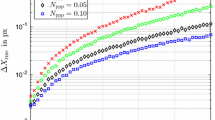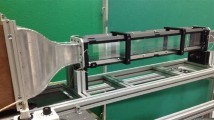Abstract
Particle Image Velocimetry can provide detailed velocity field information that has unparalleled value to both experimentalists and computational fluid dynamicists. As with any measurement technique, it is important to assess the error associated with the measurements.
The PIV measurement chain contains several stages where error is introduced. The dynamics of the seed particles determine how well they represent the local fluid velocity. Acquiring the image, whether photographically or electronically, will introduce aberrations, distortion, diffraction, and positioning uncertainties. The image analysis procedure to determine particle displacements is the final step in the measurement chain. This paper considers the error in this step of the measurement chain.
Synthetic images were generated with controlled levels of the following quantities: background mean illumination, background illumination standard deviation, mean particle diameter, number of paired particles, the ratio of unpaired particles to paired particles, displacement magnitude, and displacement direction. The analysis method tested is a generic autocorrelation technique using a two-dimensional forward FFT, PSD calculation, inverse FFT, and a peak detection algorithm based on a decreasing threshold search with subsequent sub-pixel interpolation. The error analysis principles demonstrated, however, could easily be applied to other algorithms including those implementing cross-correlation techniques.
The error in the analysis technique is characterised by four quantities: the bias in the displacement magnitude, the precision index of the displacement magnitude, the bias in the displacement direction, and the precision index of the displacement direction. Each independent variable was varied over a specified range and the behaviour of the four dependent variables observed.
The results showed a clear ability for this error assessment technique to illustrate the reliable operating range for each parameter. The variation in error with parameter level tended to be similar in all cases. There was a significant portion of the range where the error was very low. Then, at some critical value, the analysis technique broke down and the error became quite high.
Similar content being viewed by others
Abbreviations
- B :
-
Bias limit
- I o :
-
Intensity at centre of particle
- I :
-
Intensity of particles
- N :
-
Number of particles
- \(\vec R\) :
-
Displacement
- R :
-
Displacement magnitude
- r :
-
Distance from centre of particle
- S :
-
Precision index
- U :
-
Uncertainty
- z :
-
Autocorrelation function
- Δi :
-
Pixel displacement of autocorrelation peak
- Δj :
-
Pixel displacement of autocorrelation peak
- η:
-
Local coordinate axis
- μ:
-
Mean
- σ2 :
-
Variance
- θ:
-
Displacement direction
- ξ:
-
Local coordinate axis
- b :
-
Background
- D :
-
Particle diameter
- I :
-
Image intensity
- i :
-
Pixel grid index
- j :
-
Pixel grid index
- max:
-
Location of peak in autocorrelation function
- p :
-
Paired particles
- s :
-
Spurious particles
References
Adrian, R. J., Multi-point Optical Measurements of Simultaneous Vectors in Unsteady Flow — A Review, International Journal of Heat & Fluid Flow, 7(1986), 127–145.
Adrian, R. J., Particle-imaging Techniques for Experimental Fluid Mechanics, Ann. Rev. Fluid Mech., 23(1991), 261–304.
ANSI/ASME PTC 19.1-1985, Part 1, Measurement Uncertainty, The American Society of Mechanical Engineers (1986), New York.
Guezennec, Y. G. and Kiritsis, N., Statistical Investigation of Errors in Particle Image Velocimetry, Experiments in Fluids, 10(1990), 138–146.
Keane, R. D. and Adrian, R. J., Optimisation of Particle Image Velocimeters. Part I: Double pulsed systems, Measurement Science Technology, 1(1990), 1202–1215.
Montgomery, D. C., Design and Analysis of Experiments (Third Edition), (1991), John Wiley & Sons Inc.
Press, W. H., Flannery, B. P., Teukolsky, S. A., and Vetterling, W. T., Numerical Recipes in C: The Art of Scientific Computing, (1988), Cambridge University Press.
Willert, C. E. and Gharib, M., Digital Particle Image Velocimetry, Experiments in Fluids, 10(1991), 181–193.
Author information
Authors and Affiliations
Additional information
Authors’ Profiles Dr. Bugg is an Associate Professor of Mechanical Engineering at the University of Saskatchewan, Canada. He obtained his Ph.D. from the University of Calgary in 1991 in the area of bubble dynamics. His research interests are computational fluid dynamics and particle image velocimetry pertaining to fundamental studies of two-phase flow phenomena.
Dr. Rezkallah is a Professor of Mechanical Engineering at the University of Saskatchewan, Canada. In 1987, he obtained his Ph.D. from the University of Manitoba in the area of two-phase flow and heat transfer. In 1988, Dr. Rezkallah established the Microgravity Research Group. He has published extensively in this area, and has been the guest speaker in several national and international conferences and workshops.
Rights and permissions
About this article
Cite this article
Bugg, J.D., Rezkallah, K.S. An analysis of noise in PIV images. J Vis 1, 217–226 (1998). https://doi.org/10.1007/BF03182515
Issue Date:
DOI: https://doi.org/10.1007/BF03182515




